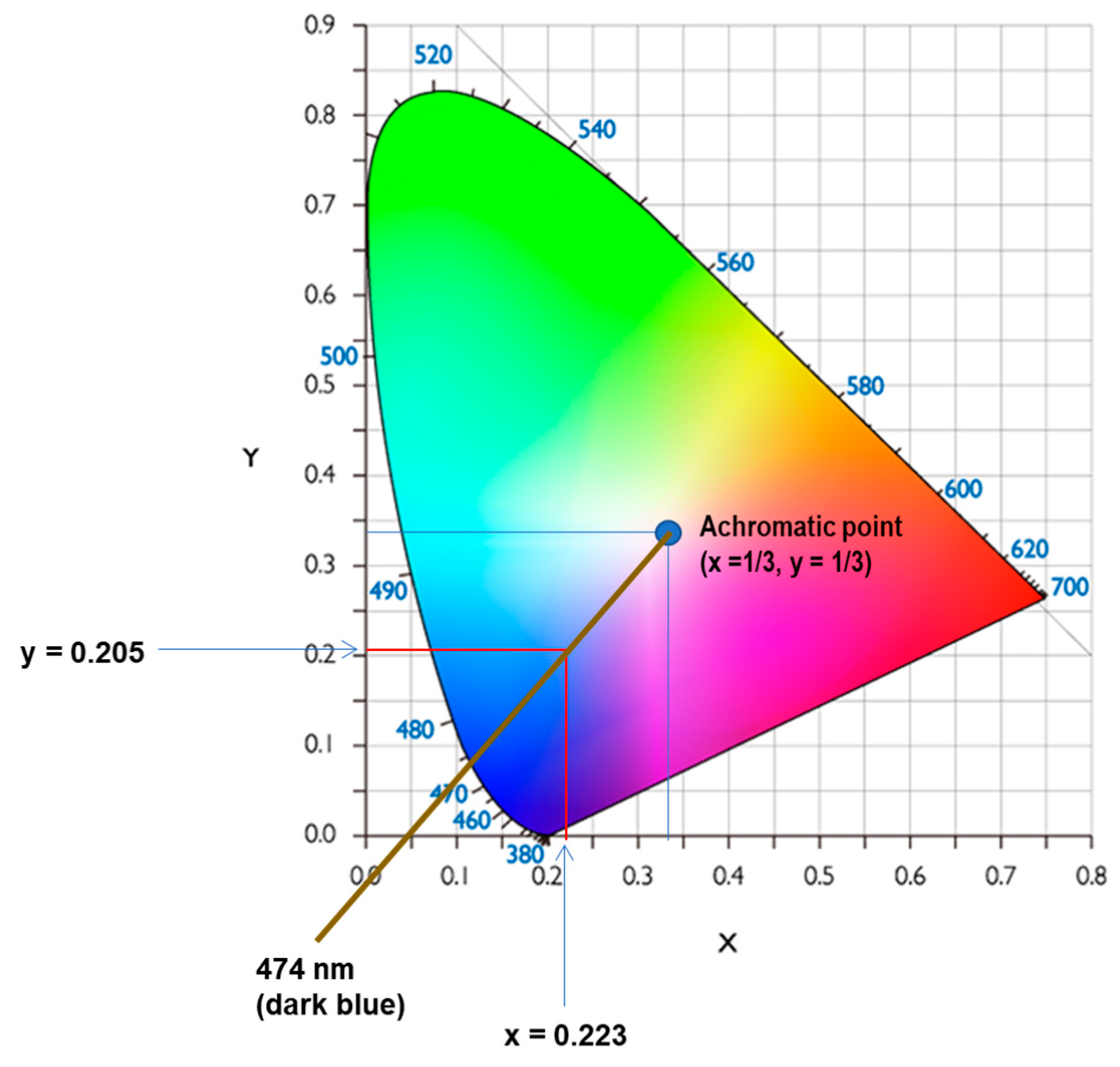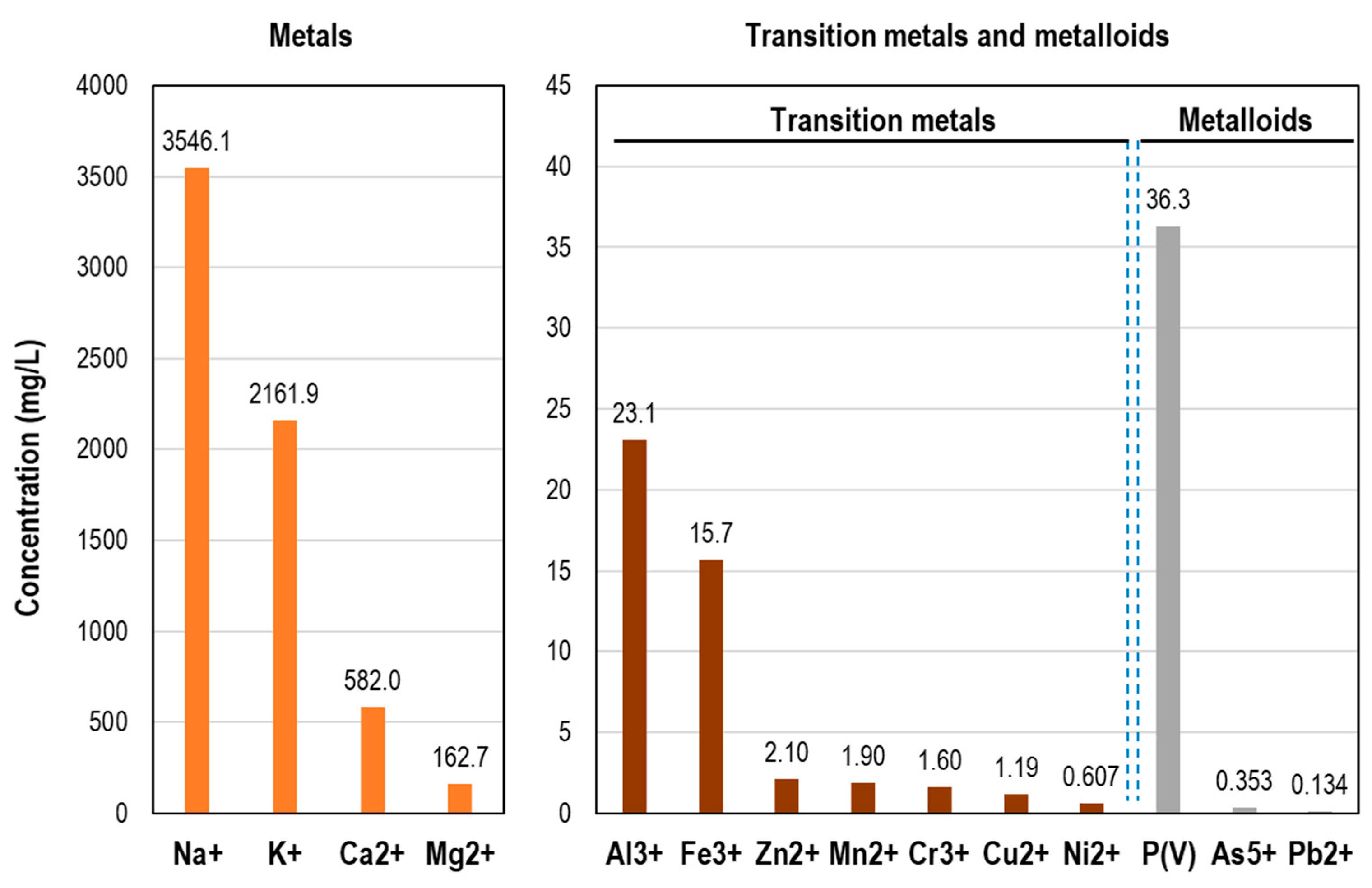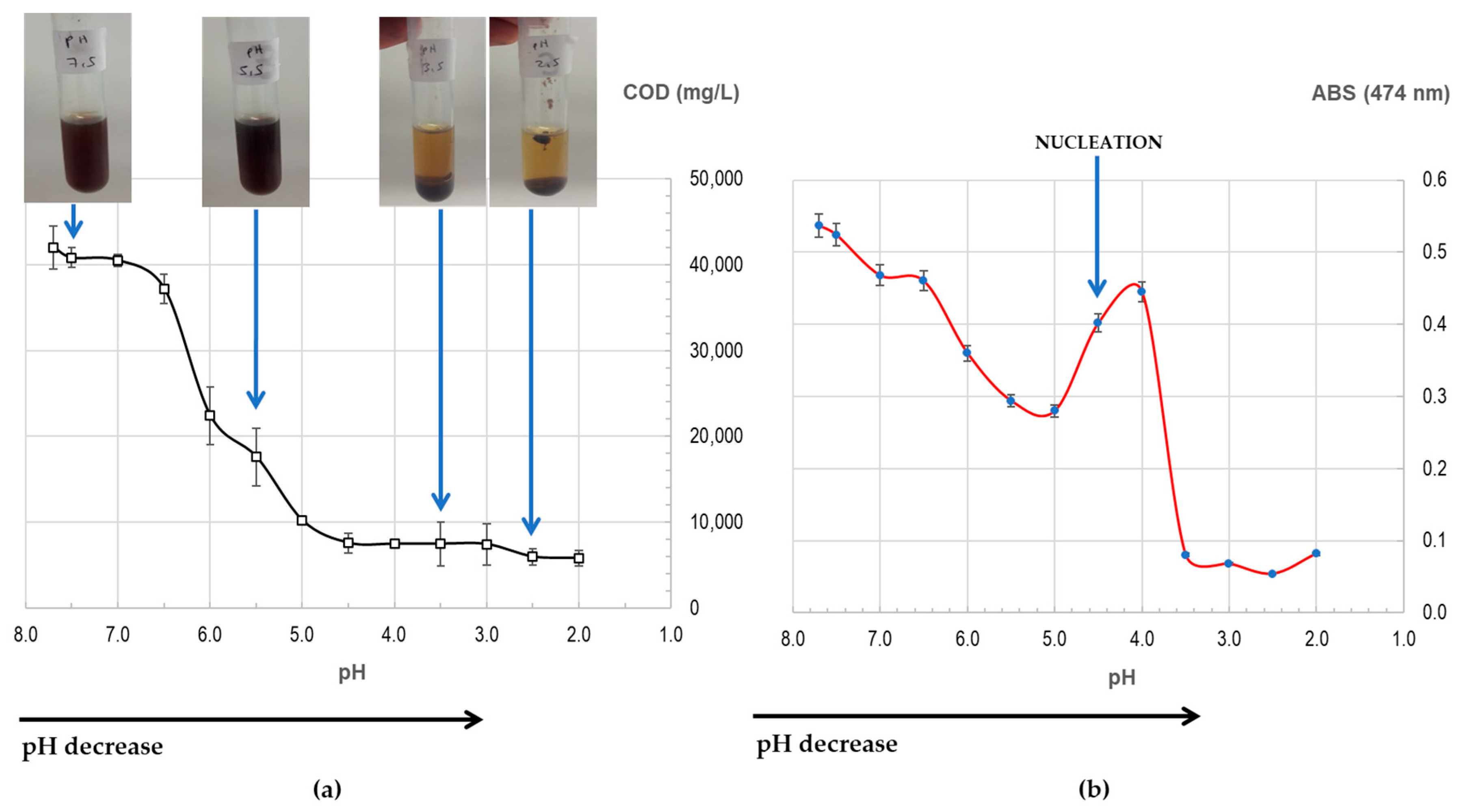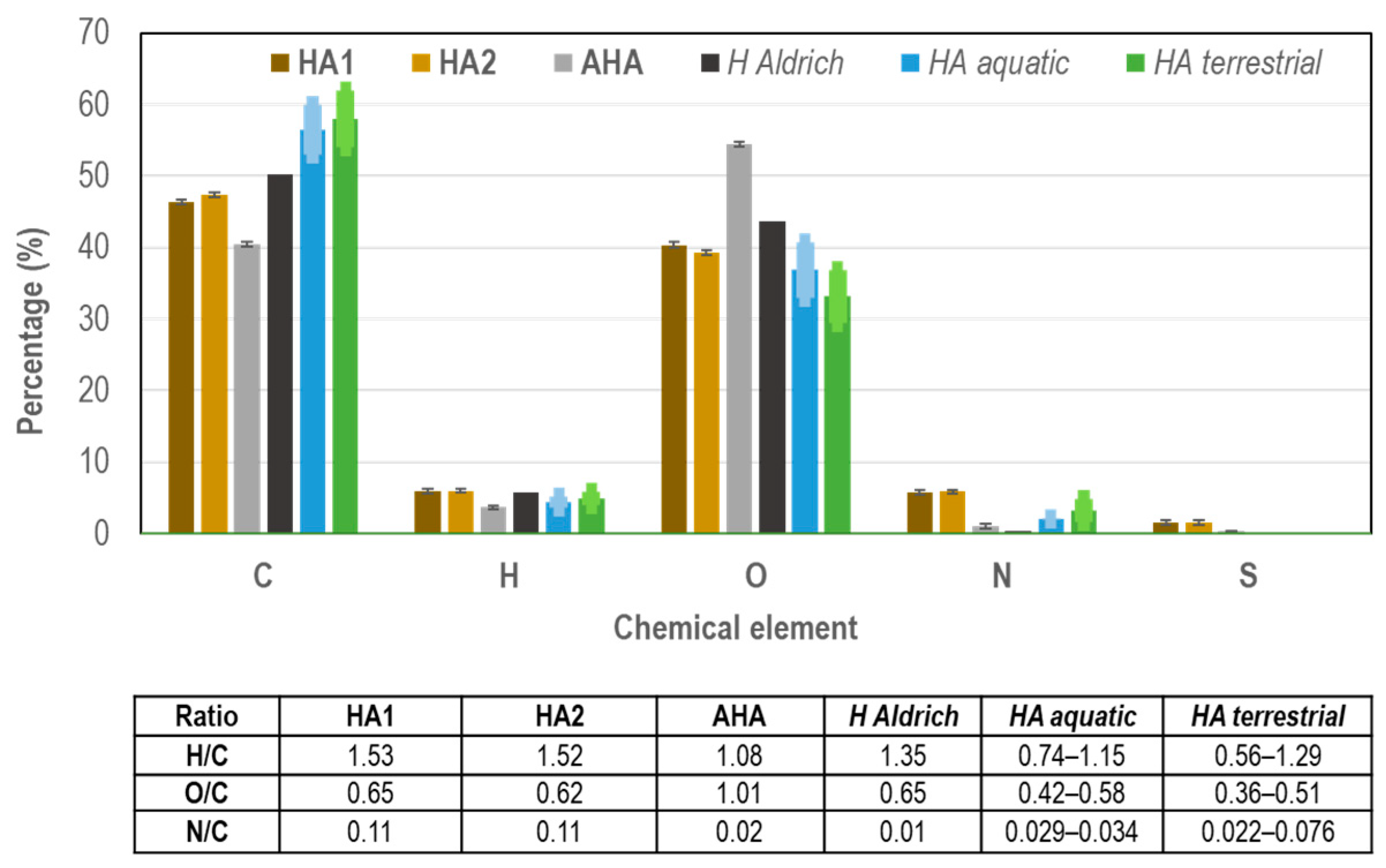Presence of Humic Acids in Landfill Leachate and Treatment by Flocculation at Low pH to Reduce High Pollution of This Liquid
Abstract
1. Introduction
2. Materials and Methods
2.1. Characterisation of Landfill Leachate
2.2. Analysis of Humic Acids
2.3. Reduction in pH
3. Results and Discussion
3.1. Composition of Landfill Leachate
3.2. Flocculation of Landfill Leachate at Low pH
3.3. Humic Acids Characterisation
3.4. Application, Scalability, and Sustainability
4. Conclusions
Supplementary Materials
Author Contributions
Funding
Institutional Review Board Statement
Informed Consent Statement
Data Availability Statement
Acknowledgments
Conflicts of Interest
References
- Renou, S.; Givaudan, J.G.; Poulain, S.; Dirassouyan, F.; Moulin, P. Landfill leachate treatment: Review and opportunity. J. Hazard. Mater. 2008, 150, 468–493. [Google Scholar] [CrossRef] [PubMed]
- Wiszniowski, J.; Robert, D.; Surmacz-Gorska, J.; Miksch, K.; Weber, J.V. Landfill leachate treatment methods: A review. Environ. Chem. Let. 2006, 4, 51–61. [Google Scholar] [CrossRef]
- Zhang, S.; Peng, Y.; Wang, S.; Zheng, S.; Gou, J. Organic matter and concentrated nitrogen removal by shortcut nitrification and denitrification from municipal landfill leachate. J. Environ. Sci. 2007, 19, 647–651. [Google Scholar] [CrossRef]
- Kheradmand, S.; Karimi-Jashni, A.; Sartaj, M. Treatment of municipal landfill leachate using a combined anaerobic digester and activated sludge system. Waste Manag. 2010, 30, 1025–1031. [Google Scholar] [CrossRef] [PubMed]
- Li, H.; Zhou, S.; Sun, Y.; Feng, P.; Li, J. Advanced treatment of landfill leachate by a new combination process in a full-scale plant. J. Hazard. Mater. 2009, 172, 408–415. [Google Scholar] [CrossRef] [PubMed]
- Wu, Y.; Zhou, S.; Ye, X.; Chen, D.; Zheng, K.; Qin, F. Transformation of pollutants in landfill leachate treated by a combined sequence batch reactor, coagulation, Fenton oxidation and biological aerated filter technology. Proc. Saf. Environ. Protec. 2011, 89, 112–120. [Google Scholar] [CrossRef]
- Mahmud, K.; Hossain, M.D.; Shams, S. Different treatment strategies for highly polluted landfill leachate in developing countries. Waste Manag. 2012, 32, 2096–2105. [Google Scholar] [CrossRef] [PubMed]
- Ding, A.; Zhang, Z.; Fu, J.; Cheng, L. Biological control of leachate from municipal landfills. Chemosphere 2001, 44, 1–8. [Google Scholar] [CrossRef] [PubMed]
- Chaturvedi, H.; Kaushal, P. Comparative study of different biological processes for non-segregated municipal solid waste (MSW) leachate treatment. Environ. Technol. Innov. 2018, 9, 134–139. [Google Scholar] [CrossRef]
- Pi, K.W.; Li, Z.; Wan, D.J.; Gao, L.X. Pretreatment of municipal landfill leachate by a combined process. Proc. Saf. Environ. Protec. 2009, 87, 191–196. [Google Scholar] [CrossRef]
- Cotman, M.; Gotvajn, A.Z. Comparison of different physico-chemical methods for the removal of toxicants from landfill leachate. J. Hazard. Mater. 2010, 178, 298–305. [Google Scholar] [CrossRef] [PubMed]
- Martins, C.L.; Fernandes, H.; Costa, R.H.R. Landfill leachate treatment as measured by nitrogen transformations in stabilization ponds. Bioresour. Technol. 2013, 147, 562–568. [Google Scholar] [CrossRef] [PubMed]
- Tamrat, M.; Costa, C.; Márquez, M.C. Biological treatment of leachate from solid wastes: Kinetic study and simulation. Biochem. Eng. J. 2012, 66, 46–51. [Google Scholar] [CrossRef]
- Costa, C.; Domínguez, J.; Autrán, B.; Márquez, M.C. Dynamic Modeling of biological treatment of leachates from solid wastes. Environ. Model. Assess. 2018, 23, 165–173. [Google Scholar] [CrossRef]
- Domínguez, J.; Costa, C.; Autrán, B.; Márquez, M.C. Characterization and biological stabilization of leachates from solid wastes in north-centre Spain for agricultural application. Waste Biomass Valorization 2019, 10, 167–178. [Google Scholar] [CrossRef]
- Marañón, E.; Castrillón, L.; Fernández-Nava, Y.; Fernández-Méndez, A.; Fernández-Sánchez, A. Coagulation-flocculation as a pretreatment Process at a landfill leachate nitrification-denitrification plant. J. Hazard. Mater. 2008, 156, 538–544. [Google Scholar] [CrossRef] [PubMed]
- Salem, Z.; Hamouri, K.; Djemaa, R.; Allia, K. Evaluation of landfill leachate pollution and treatment. Desalination 2008, 220, 108–114. [Google Scholar] [CrossRef]
- Castrillón, L.; Fernández-Nava, Y.; Ulmanu, M.; Anger, I.; Marañón, E. Physico-chemical and biological treatment of MSW landfill leachate. Waste Manag. 2010, 30, 228–235. [Google Scholar] [CrossRef] [PubMed]
- Chemlal, R.; Azzouz, L.; Kernani, R.; Abdi, N.; Lounici, H.; Grib, H.; Mameri, N.; Drouiche, N. Combination of advanced oxidation and biological processes for the leachate treatment. Ecol. Eng. 2014, 73, 281–289. [Google Scholar] [CrossRef]
- Marañón, E.; Castrillón, L.; Fernández-Nava, Y.; Fernández-Méndez, A.; Fernández-Sánchez, A. Colour, turbidity and COD removal from old landfill leachate by coagulation-flocculation treatment. Waste Manag. Res. 2010, 28, 731–737. [Google Scholar] [CrossRef] [PubMed]
- De Torres-Socías, E.; Prieto-Rodríguez, L.; Zapata, A.; Fernández-Calderero, I.; Oller, I.; Malato, S. Detailed treatment line for a specific landfill leachate remediation. Brief economic assessment. Chem. Eng. J. 2015, 261, 60–66. [Google Scholar] [CrossRef]
- Oloibiri, V.; Chys, M.; De Wandel, S.; Demeestere, K.; Van Hulle, S.W.H. Removal of organic matter and ammonium from landfill leachate through different scenarios: Operational cost evaluation in a full-scale case study of Flemish landfill. J. Environ. Manag. 2017, 203, 774–781. [Google Scholar] [CrossRef] [PubMed]
- Jiang, Z.; Yang, H.; Sun, L.; Shi, S. Integrated assessment for aerobic biodegradability of organic substances. Chemosphere 2002, 48, 133–138. [Google Scholar] [CrossRef] [PubMed]
- Kang, K.-H.; Shin, H.S.; Park, H. Characterization of humic substances present in landfill leachates with different landfill ages and its implications. Water Res. 2002, 36, 4023–4032. [Google Scholar] [CrossRef] [PubMed]
- Sír, M.; Podhola, M.; Patocka, T.; Honzajkova, Z.; Kocurek, P.; Kubal, M.; Kuras, M. The effect of humic acids on the reverse osmosis treatment of hazardous landfill leachate. J. Hazard. Mater. 2012, 207–208, 86–90. [Google Scholar] [CrossRef] [PubMed]
- Torretta, V.; Ferronato, N.; Katsoyiannis, I.A.; Tolkou, A.K.; Airoldi, M. Novel and conventional technologies for landfill leachate treatment: A review. Sustainability 2017, 9, 9. [Google Scholar] [CrossRef]
- Zouboulis, A.I.; Chai, X.-L.; Katsoyiannis, I.A. The application of bioflocculant for the removal of humic acids from stabilized landfill leachates. J. Environ. Manag. 2004, 70, 35–41. [Google Scholar] [CrossRef]
- Tong, H.; Yin, K.; Ge, L.; Giannis, A.; Chuan, V.W.L.; Wang, J.-Y. Monitoring transitory profiles of leachate humic substances in landfill aeration reactors in mesophilic and thermophilic conditions. J. Hazard. Mater. 2015, 287, 342–348. [Google Scholar] [CrossRef]
- Oulego, P.; Collado, S.; Laca, A.; Díaz, M. Impact of leachate composition on the advanced oxidation treatment. Water Res. 2016, 88, 389–402. [Google Scholar] [CrossRef] [PubMed]
- Qi, G.; Yue, D.; Nie, Y. Characterization of humic substances in bio-treated municipal solid waste landfill leachate. Front. Environ. Sci. Eng. 2012, 6, 711–716. [Google Scholar] [CrossRef]
- Zhang, D.; Vahala, R.; Wang, Y.; Smets, B.F. Microbes in biological processes for municipal landfill leachate treatment: Community, function and interaction. Int. Biodeterior. Biodegrad. 2016, 113, 88–96. [Google Scholar] [CrossRef]
- Christensen, J.B.; Jensen, D.L.; Grøn, C.; Filip, Z.; Christensen, T.H. Characterization of the dissolved organic carbon in landfill leachate polluted groundwater. Water Res. 1998, 32, 125–135. [Google Scholar] [CrossRef]
- Graber, E.R.; Rudich, Y. Atmospheric HULIS: How humic-like are they? A comprehensive and critical review. Atmos. Chem. Phys. 2006, 6, 729–753. [Google Scholar] [CrossRef]
- Gomes de Melo, B.A.; Lopes Motta, F.; Andrade Santana, M.H. Humic acids: Structural properties and multiple functionalities for novel technological developments. Mater. Sci. Eng. C 2016, 62, 967–974. [Google Scholar] [CrossRef] [PubMed]
- Dia, O.; Drogui, P.; Buelna, G.; Dubé, R. Hybrid process, electrocoagulation-biofiltration for landfill leachate treatment. Waste Manag. 2018, 75, 391–399. [Google Scholar] [CrossRef] [PubMed]
- Motta, F.L.; Melo, B.A.G.; Santana, M.H.A. Deprotonation and protonation of humic acids as a strategy for the technological development of pH-responsive nanoparticles with fungicidal potential. New Biotechnol. 2016, 33, 773–780. [Google Scholar] [CrossRef] [PubMed]
- Álvarez-Puebla, R.A.; Garrido, J.J. Effect of pH on the aggregation of a gray humic acid in colloidal and solid states. Chemosphere 2005, 57, 659–667. [Google Scholar] [CrossRef]
- Souza, F.D.; Roca Bragança, S. Humic Acid as Dispersant of an Alumina Suspension and its Rheological Behaviour. Mater. Res. 2018, 21, e20170759. [Google Scholar] [CrossRef]
- APHA; AWWA; WEF. Standard Methods for the Examination of Water and Wastewater, 23rd ed.; American Public Health Association: Washington DC, USA, 2017. [Google Scholar]
- UNE-EN ISO 10304-1:2009; Determination of Dissolved Anions by Liquid Chromatography of Ions—Part 1: Determination of Bromide, Chloride, Fluoride, Nitrate, Nitrite, Phosphate and Sulphate. AENOR: Madrid, Spain, 2009.
- Abbt-Braun, G.; Lankes, U.; Frimmel, F.H. Structural characterization of aquatic humic substances–The need for a multiple method approach. Aquat. Sci. 2004, 66, 151–170. [Google Scholar] [CrossRef]
- Ziyang, L.; Bin, D.; Xiaoli, C.; Yu, S.; Youcai, Z.; Nanwen, Z. Characterization of refuse Landfill leachates of three different stages in landfill stabilization process. J. Environ. Sci. 2009, 21, 1309–1314. [Google Scholar] [CrossRef]
- Vaverková, M.D.; Elbl, J.; Koda, E.; Adamcová, D.; Bilgin, A.; Lukas, V.; Podlasek, A.; Kintl, A.; Wdowska, M.; Brtnický, M. Chemical Composition and Hazardous Effects of Leachate from the Active Municipal Solid Waste Landfill Surrounded by Farmlands. Sustainability 2020, 12, 4531. [Google Scholar] [CrossRef]
- Guo, X.; Liu, H.; Wu, S. Humic substances developed during organic waste composting: Formation mechanisms, structural properties, and agronomic functions. Sci. Total Environ. 2019, 662, 501–510. [Google Scholar] [CrossRef] [PubMed]
- Tejera, J.; Miranda, R.; Hermosilla, D.; Urra, I.; Negro, C.; Blanco, A. Treatment of a Mature Landfill Leachate: Comparison between Homogeneous and Heterogeneous Photo-Fenton with Different Pretreatments. Water 2019, 11, 1849. [Google Scholar] [CrossRef]
- Aziz, H.A.; Rahim, N.A.; Ramli, S.F.; Alazaiza, M.Y.D.; Omar, F.M.; Hung, Y.-T. Potential Use of Dimocarpus longan Seeds as a Flocculant in Landfill Leachate Treatment. Water 2018, 10, 1672. [Google Scholar] [CrossRef]
- Matovelle, C.; Quinteros, M.; Heras, D. Machine Learning Techniques in Dosing Coagulants and Biopolymers for Treating Leachate Generated in Landfills. Water 2023, 15, 4200. [Google Scholar] [CrossRef]
- Kamal, A.; Makhatova, A.; Yergali, B.; Baidullayeva, A.; Satayeva, A.; Kim, J.; Inglezakis, V.J.; Poulopoulos, S.G.; Arkhangelsky, E. Biological Treatment, Advanced Oxidation and Membrane Separation for Landfill Leachate Treatment: A Review. Sustainability 2022, 14, 14427. [Google Scholar] [CrossRef]
- Remmas, N.; Manfe, N.; Zerva, I.; Melidis, P.; Raga, R.; Ntougias, S. A Critical Review on the Microbial Ecology of Landfill Leachate Treatment Systems. Sustainability 2023, 15, 949. [Google Scholar] [CrossRef]
- Wdowczyk, A.; Szymańska-Pulikowska, A. Differences in the Composition of Leachate from Active and Non-Operational Municipal Waste Landfills in Poland. Water 2020, 12, 3129. [Google Scholar] [CrossRef]
- Ramli, S.F.; Aziz, H.A.; Omar, F.M.; Yusoff, M.S.; Halim, H.; Kamaruddin, M.A.; Ariffin, K.S.; Hung, Y.-T. Reduction of COD and Highly Coloured Mature Landfill Leachate by Tin Tetrachloride with Rubber Seed and Polyacrylamide. Water 2021, 13, 3062. [Google Scholar] [CrossRef]
- Baalousha, M.; Motelica-Heino, M.; Le Coustumer, P. Conformation and size of humic substances: Effects of major cation concentration and type, pH, salinity, and residence time. Colloids Surf. A Physicochem. Eng. Asp. 2006, 272, 48–55. [Google Scholar] [CrossRef]
- Pinedo, L.M.; Riascos, B.D.; Quintero, X.E.; Costa, C. Mechanism of pH sensitive flocculation for organic load and colour reduction in landfill leachate. Waste Manag. 2022, 144, 163–172. [Google Scholar] [CrossRef]
- De Castro, A.L.; dos Santos, R.F.; de Souza, J.C.; Izário, H.J. Characterization of controlled landfill leachate from the city of Guaratinguetá-SP, Brazil. Ambiente Agua-Interdiscip. J. Appl. Sci. 2018, 13, 1. [Google Scholar] [CrossRef]
- Tanaka, T. Functional groups and reactivity of size-fractionated Aldrich humic acid. Thermochim. Acta 2012, 532, 60–64. [Google Scholar] [CrossRef]
- Weiming, C.; Qibin, L. Elimination of UV-quenching substances from MBR- and SAARB-treated mature landfill leachates in an ozonation process: A comparative study. Chemosphere 2020, 242, 125256. [Google Scholar] [CrossRef]
- Pisharody, L.; Gopinath, A.; Malhotra, M.; Nidheesh, P.V.; Kumar, M.S. Occurrence of organic micropollutants in municipal landfill leachate and its effective treatment by advanced oxidation processes. Chemosphere 2022, 287, 132216. [Google Scholar] [CrossRef]
- Liu, Y.; Chen, Y.; Da, Y.; Xie, F.; Wang, J. Advanced treatment of landfill leachate using integrated coagulation/photo-Fenton process through in-situ generated nascent Al3+ and H2O2 by Cl, N co-doped aluminum-graphite composite. Appl. Catal. B Environ. 2022, 304, 121003. [Google Scholar] [CrossRef]
- Chen, W.; Gu, Z.; Wen, P.; Li, Q. Degradation of refractory organic contaminants in membrane concentrates from landfill leachate by a combined coagulation-ozonation process. Chemosphere 2019, 217, 411–422. [Google Scholar] [CrossRef] [PubMed]
- Wang, H.; Xiao, W.; Zhang, C.; Sun, Y.; Wang, N.Y.; Gong, Z.; Zhan, M.; Fu, Y.; Liu, K. Effective removal of refractory organic contaminants from reverse osmosis concentrated leachate using PFS-nZVI/PMS/O3 process. Waste Manag. 2021, 128, 55–63. [Google Scholar] [CrossRef] [PubMed]
- Tawakkoly, B.; Alizadehdakhel, A.; Dorosti, F. Evaluation of COD and turbidity removal from compost leachate wastewater using Salvia hispanica as a natural coagulant. Ind. Crops Prod. 2019, 137, 323–331. [Google Scholar] [CrossRef]
- Nazia, S.; Sahu, N.; Jegatheesan, V.; Bhargava, S.K.; Sridhar, S. Integration of ultrafiltration membrane process with chemical coagulation for proficient treatment of old industrial landfill leachate. Chem. Eng. J. 2021, 412, 128598. [Google Scholar] [CrossRef]
- Kwarciak-Kozłowska, A.; Fijałkowski, K.L. Efficiency assessment of municipal landfill leachate treatment during advanced oxidation process (AOP) with biochar adsorption (BC). J. Environ. Manag. 2021, 287, 112309. [Google Scholar] [CrossRef] [PubMed]
- Xue, W.-J.; Cui, Y.-H.; Liu, Z.-Q.; Yang, S.-Q.; Li, J.-Y.; Guo, X.-L. Treatment of landfill leachate nanofiltration concentrate after ultrafiltration by electrochemically assisted heat activation of peroxydisulfate. Sep. Purif. Technol. 2020, 231, 115928. [Google Scholar] [CrossRef]
- He, H.; Zhang, C.; Yang, X.; Huang, B.; Zhe, J.; Lai, C.; Liao, Z.; Pan, X. The efficient treatment of mature landfill leachate using tower bipolar electrode flocculation-oxidation combined with electrochemical biofilm reactors. Water Res. 2020, 230, 119544. [Google Scholar] [CrossRef]
- Gao, B.; Yang, X.; Dasi, E.A.; Lam, T.; Arias, M.E.; Ergas, S.J. Enhanced landfill leachate treatment in sequencing batch biofilm reactors (SBBRs) amended with zeolite and biochar. J. Chem. Technol. Biotechnol. 2022, 97, 759–770. [Google Scholar] [CrossRef]
- Long, C.; Zhu, B.; Liu, W.; Li, Q. Coagulation combined with electro-Fe0/H2O2 reaction for effective treatment of landfill leachate effluent of membrane bioreactor. Water 2023, 15, 1158. [Google Scholar] [CrossRef]
- Cheng, S.Y.; Show, P.; Juan, J.C.; Chang, J.; Lau, B.F.; Lai, S.H.; Ng, E.P.; Yian, H.C.; Ling, T.C. Landfill leachate wastewater treatment to facilitate resource recovery by a coagulation-flocculation process via hydrogen bond. Chemosphere 2021, 262, 127829. [Google Scholar] [CrossRef] [PubMed]
- Christl, I. Magnesium binding by terrestrial humic acids. Environ. Chem. 2018, 15, 317–324. [Google Scholar] [CrossRef]








| Parameter | Mean ± SD |
|---|---|
| pH | 7.7 ± 0.1 |
| COD | 42,000 ± 2516 |
| TS | 16,410 ± 486 |
| VS | 10,076 ± 620 |
| Colour | 0.537 ± 0.000 |
| Norg | 3795 ± 314 |
| NH4+ | 2484 ± 340 |
| NO3− | 417 ± 115 |
| NO2− | 11 ± 1 |
| SO42− | 223 ± 64 |
| PO43− | 39 ± 18 |
| Cl− | 11,710 ± 1978 |
Disclaimer/Publisher’s Note: The statements, opinions and data contained in all publications are solely those of the individual author(s) and contributor(s) and not of MDPI and/or the editor(s). MDPI and/or the editor(s) disclaim responsibility for any injury to people or property resulting from any ideas, methods, instructions or products referred to in the content. |
© 2025 by the authors. Licensee MDPI, Basel, Switzerland. This article is an open access article distributed under the terms and conditions of the Creative Commons Attribution (CC BY) license (https://creativecommons.org/licenses/by/4.0/).
Share and Cite
Costa, C.; Pinedo, M.L.; Riascos, B.D. Presence of Humic Acids in Landfill Leachate and Treatment by Flocculation at Low pH to Reduce High Pollution of This Liquid. Sustainability 2025, 17, 481. https://doi.org/10.3390/su17020481
Costa C, Pinedo ML, Riascos BD. Presence of Humic Acids in Landfill Leachate and Treatment by Flocculation at Low pH to Reduce High Pollution of This Liquid. Sustainability. 2025; 17(2):481. https://doi.org/10.3390/su17020481
Chicago/Turabian StyleCosta, Carlos, M. Laura Pinedo, and Brayan D. Riascos. 2025. "Presence of Humic Acids in Landfill Leachate and Treatment by Flocculation at Low pH to Reduce High Pollution of This Liquid" Sustainability 17, no. 2: 481. https://doi.org/10.3390/su17020481
APA StyleCosta, C., Pinedo, M. L., & Riascos, B. D. (2025). Presence of Humic Acids in Landfill Leachate and Treatment by Flocculation at Low pH to Reduce High Pollution of This Liquid. Sustainability, 17(2), 481. https://doi.org/10.3390/su17020481







